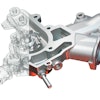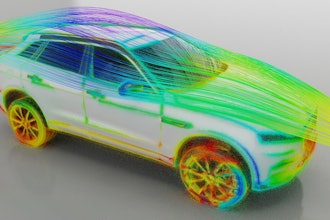Sometimes, the need for an ERP to handle the distribution portion of a manufacturer's business is minor; sometimes, acute. Aerospace and defense companies don’t typically make the special tools sent out to maintenance hangars and surely not their logo-printed shirts, hats, jackets and other promotional materials as well as models and miniatures of their products. Or, consider a company that produces RFID readers. In its manufacturing process, it orders printed circuit boards from one vendor, LEDs from another vendor and plastic housing or steel housing from yet another vendor(s). The various RFID readers — some potted; some not, different colors, various read ranges — are then boxed, the boxes put into skids with shipping instructions applied and sent to the customer. This process is classic discrete manufacturing. For this function, the organization would select a manufacturing ERP.
owever, this company doesn’t make long range read solutions because that’s an entirely different technology and the numbers don’t result in a profit by setting up manufacturing for these units. Yet, the company needs such units to fill out its line so prospects can buy all ID readers from one manufacturer, no matter the read range. So, the company buys long range readers from an OEM manufacturer who puts the buyer's label on it in a box with their logo and information. Like the units it does manufacture, the company puts the boxes of long range readers into skids and applies shipping label instructions. This is classic distribution. For this function, the organization would want a distribution ERP.
Similar to that needed by a wholesale distributor, the distribution cloud ERP for the manufacturer must efficiently manage all aspects of the supply chain from first customer contact through final shipping and returns... a comprehensive set of capabilities that include purchasing, warehousing, sales, shipping and customer service. Inventory should be identifiable by location ID, location number and, optionally, by lot and serial number.
Benefits of a Cloud Distribution App to Manufacturers
Having the ERP, whether manufacturing or distribution, in the cloud becomes crucial with such companies. Collaborating among various locations is a main objective. With the cloud, information is available to all participants at once. No lengthy faxes or messy attachments. Files are shared virtually right now for all. And, of course, there are all the benefits that the cloud brings to everyone — significant and tangible cost reductions in both IT staff and hardware infrastructure in addition to the intangible benefits of cloud solutions, such as access anytime from anywhere from virtually any device.
However, simply being on the cloud is not enough. Manufacturers with a distribution function also require features that typical cloud ERPs do not provide, including functions such as:
-
Support multiple ship-to and bill-to addresses for any given customer,
-
Let customer agreements be used to manage special pricing arrangements and discounting schemes,
-
Support the allocation of finished goods inventory to Sales Order lines if needed,
-
Allow for straight-forward yet sophisticated product pricing and discount options for numerous pricing schemes as needed in today's market place,
-
Provide the ability to create purchase orders from sales orders and offer the capability to drop ship these purchase orders directly to the customer or to bring the goods directly into the company’s main warehouse or distribution center,
-
Offer item usage history for every material movement which can be utilized to set policy and
-
Make it easy to manage credit checks by providing various selections as well as user options where credit checks are performed.
Specific Functions that Distribution ERP Additionally Provides
Cloud ERP software created specifically for the distribution function enables companies to efficiently manage all aspects of the Supply Chain from first customer contact through final shipping and returns. When fully integrated with a CRM solution, cloud ERP created for Wholesale Distributors - or manufacturers also having a distributor component to their business - provides a comprehensive set of capabilities that include Purchasing, Warehousing, Sales, Shipping and Customer Service. Inventory can be identified by Location ID, Location Number and, optionally, by Lot and Serial Number, this latter especially important to such manufacturers who OEM some medical equipment or other regulated products. In addition, Inventory can also be segregated by Site and Plant/Division.
Inventory can be easily transferred between locations. Full cycle count reporting promotes inventory accuracy. Complete audit trails are created for all Inventory transactions and all financial information is integrated with accounting. The cloud ERP created specifically for Wholesale Distributors will also retain historical data by Product and/or Customer, along with other attributes, providing data for business analytics and forecasting.
With such a Cloud ERP, distribution companies - and manufacturers who distribute - can also use the Bill of Materials feature to describe and manage kits and products that are assembled-to-order. Sales Order Entry capabilities will include a robust Available-to-Promise feature which includes Allocations and time-phased requirements. Shipments can be made directly from Suppliers to customers with Purchase Orders tied to Sales Orders. Sales tax and address verification integrations can also be included.
Cloud ERP created specifically for Wholesale Distributors will also support Centralized Sales Order entry with fulfillment from multiple Distribution Centers. Sales operations can be centralized to control sales order fulfillment from multiple distribution centers (DC). The ERP will also handle all of the operational transactions for Pick, Pack, Ship and Invoice with complete visibility on all Orders, Shipments and Returns. A complete DRP (Distribution Requirements Planning) function is part of the standard Planning Engine. The system will automatically plan replenishments of products based upon supply, demand, forecast and re-order point. These Requisitions can then be converted to Purchase Orders which can be consolidated across multiple distribution centers.
Selecting the Cloud is Only Half the Decision
Which ERP to choose is a major decision for manufacturers alike. Yes, most will want the advantages that the cloud offers. But — and it's a big "but" — the ERP must also bring the tools they need to be successful in a fast flowing, mobile world.
Would all manufacturers need all of these distribution attributes? No. Would all distributors need all of these ERP attributes? Absolutely not. However, many of them need some of these attributes but differing ones from firm to firm. Instead of having to customize, distribution Cloud ERP modules and manufacturing Cloud ERP modules should be available to work in conjunction with each other.
Pat Garrehy is the Founder, President and CEO for Rootstock Software.




















